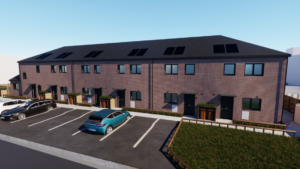Housing is broken, but there are ways to fix it
Housing needs radical solutions like never before. Tony Hutchinson has some ideas.
Reading the Housing White Paper I was reminded of the Johnny Cash song where the auto worker builds his Cadillac one piece at a time. Needless to say the result is a disappointment. The White Paper was similarly assembled with care from old policy announcements.
At a time of when there is need for a positive and innovative approach to delivering more homes the White Paper was essentially a compilation of bits and pieces, all of which we have heard before and as such do not respond in any sense to the housing catastrophe we all face.
In the 45 years I have been active in housing I do not recall a time when there was such anticipation that a radical solution to housing supply, housing affordability and housing quality was politically possible. The classic ground for public sector intervention is that the private sector cannot or will not provide a solution.
The market has been given unfettered opportunity to deliver homes for the whole community for a generation or more. The balance between landlords and the tenants in terms of protection from exploitation has swung so far in favour of the landlord that some of the much awaited tide of professional commercial landlords are voluntarily offering more security and rights than the law allows, while protection from revenge evictions is tokenistic and difficult to enforce.
The major housebuilders, no longer volume builders, control the supply of new homes for sale and can increase their profits by building fewer homes. The market for existing homes is driven by proximity to desirable schools or good commuter stations or a myriad other concerns. Wealth accumulates to those that were able to buy sooner, while aspiring owner-occupiers are denied that opportunity. The White Paper is like offering someone having a heart attack a glass of water and a soothing word.
Yes, there is no magic solution but that does not mean there is no room for radicalism.
Crucially, the government in all its forms has the ability to bring forward sufficient land to deflate the market for development land. The individual agencies which control that land cannot do this. Each one individually is tasked with maximising the return on its assets. A hospital trust cannot sell land at less than best consideration for homes even if those homes help it to provide places to discharge patients safely or accommodate its staff. One change that could make a difference is to change this mentality.
The public purse is better served by building homes at social rent, requiring less housing benefit and helping families develop a long term stake in a neighbourhood, rather than selling land to the highest bidder into a land bank where development may only take place after it has changed hands several times over 5, 10, 15 or 20 years, with the price inflating each time and none of that ‘value’ accruing to the public purse. When the site eventually is developed, it won’t be viable if any ‘affordable’ homes are built.
If a mechanism were to be devised that allowed the release of public assets at existing use value rather than an assumed value with an optimised planning consent (no contributions to affordable housing or other social goods) its operation would need to be contingent on prompt development and compliance with planning policies, especially on affordable housing. There will need to be safeguards where land is not developed or is sold.
All legal processes from valuation and land transfer to compulsory purchase and the grant of planning consent should be allowed to take into account social and economic benefits when making a decision. This is especially the case where an outcome from a programme is better health, say, reducing the cost of treating respiratory disease through warmer and drier homes. The cost here falls on the local housing authority but the benefit accrues to the NHS.
Selling land at less than best consideration is also put forward as a way to accelerate housing delivery, but if this purely transfers value from a public body to private profit this may not be the best solution. Transfer of land at a discount to the market should only be used as a tool to secure a public benefit. This could be additional, beyond policy compliance, affordable homes or homes at a greater discount (at target rent rather than ‘affordable’ rent). This needs to be backed up by rigorous scrutiny to avoid value being lost to the public purse and profit margins being inflated.
With long term borrowing costs low there is money available to build. Building creates work so taxes are paid and goods are bought, generating VAT receipts. New homes are energy efficient and cheaper to run, meaning more disposable income, which is then spent on local goods and services.
So seeing government spending as a whole – a system to support Uk plc – rather than seeing each budget as hermetically sealed from other budgets is a step forward. One that the White Paper hints at but does not fully develop. A lost opportunity.
















